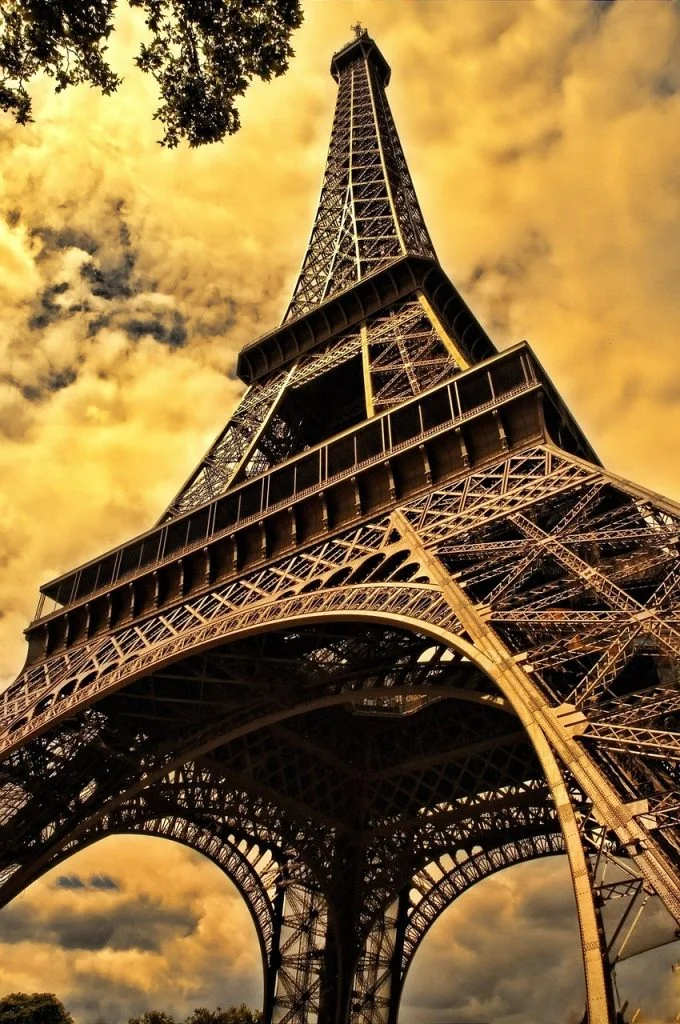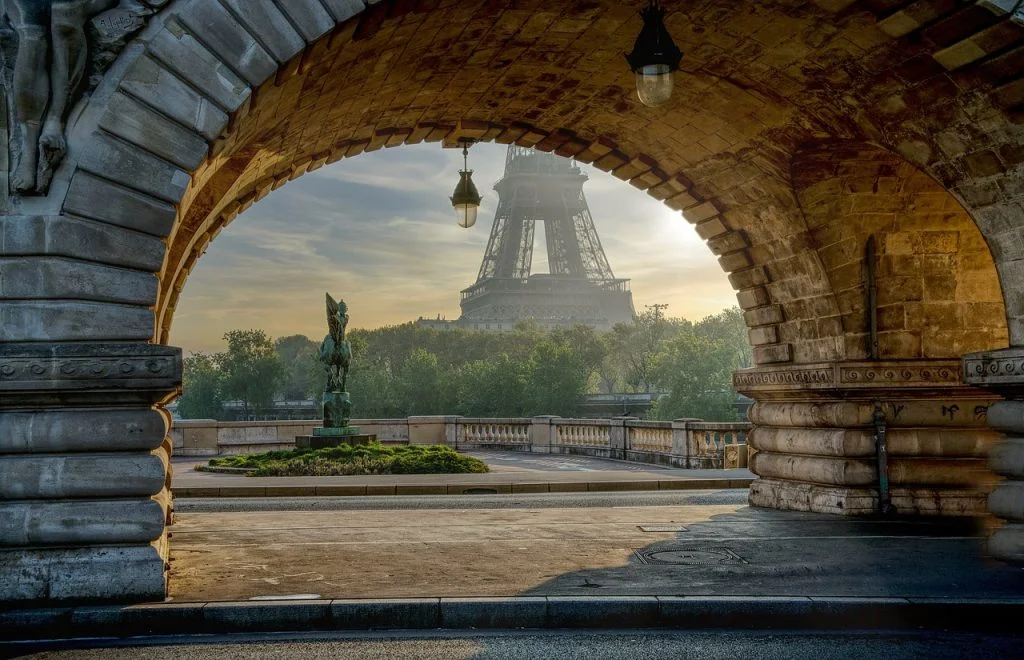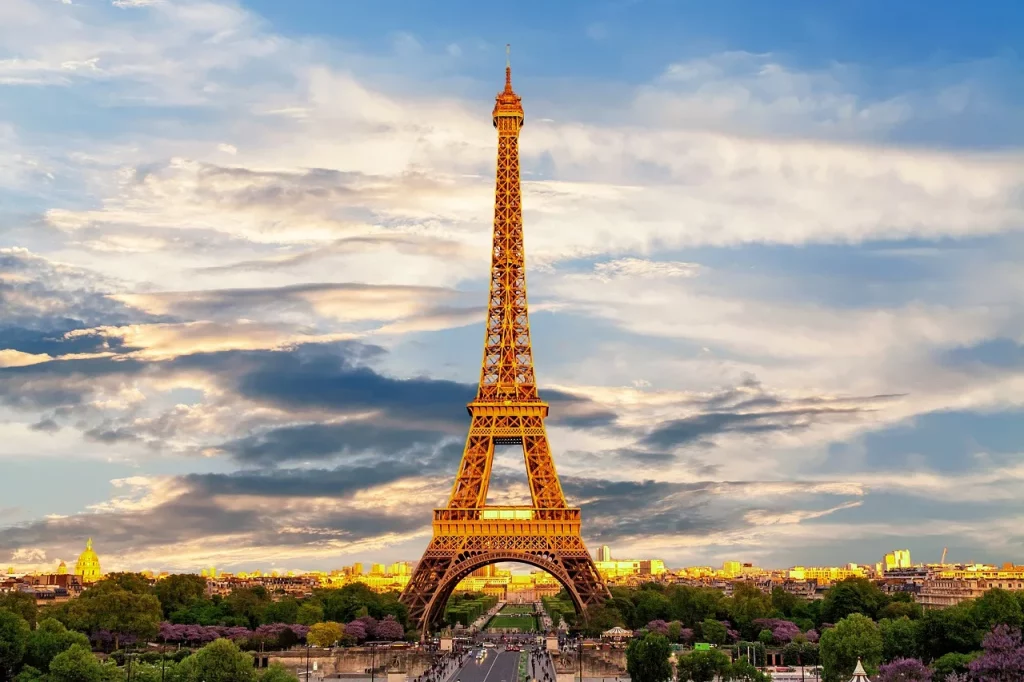There’s something magical about the Eiffel Tower. No, really. The first time I saw it, I swear it winked at me. It was a breezy spring morning, and as I strolled along the Seine, there it was, towering above the city like a celebrity on stilts. From that moment on, I was hooked.
I’ve since learned everything from its 2.5 million rivets (yes, someone counted them) to the fact that it grows by up to six inches in the summer – talk about a seasonal growth spurt!
This isn’t just a tower; it’s a living, breathing character in the heart of Paris. Ever wondered why it’s painted three different shades of brown? Well, keep reading, and I’ll spill all the Eiffel facts for you!
I left Paris and even France, because the Eiffel Tower bothered me too much.
Guy de Maupassant
Eiffel Tower Facts
Join me on an exciting exploration of the Eiffel Tower’s hidden gems. Make sure to absorb every fact, because there’s a quiz at the end of this article to see how much you’ve learned! Don’t disappoint me.
- The Eiffel Tower, a creation of Gustave Eiffel, was initially meant to be a temporary installation for the 1889 Exposition Universelle.
- This monumental structure stood as the world’s tallest at 300 meters until the Chrysler Building took over in 1930.
- Constructed from over 18,000 pieces of iron, it’s held together by a staggering 2.5 million rivets.
- Despite Gustave Eiffel getting the credit, the tower’s design was majorly contributed to by engineers Maurice Koechlin and Émile Nouguier.
- The Eiffel Tower can move up to 9 centimeters due to wind, showcasing its incredible engineering to accommodate natural forces.
- Around 60 tons of paint are required to coat the tower, a maintenance ritual performed every seven years to prevent rust.
- Though initially met with skepticism, the Eiffel Tower has become recognized as an icon of structural ingenuity.
- In the Second World War, its elevators were sabotaged, rendering the tower inaccessible. Legend says Hitler refrained from climbing due to this inconvenience.
- The tower offers three levels for visitors, with dining available on the first two and an observation deck at the summit.
- It is adorned with 20,000 bulbs, creating a dazzling light show nightly.
- Since its opening, the Eiffel Tower has welcomed over 250 million visitors.
- It was almost taken down in 1909 but was spared because of its utility as a vast radio antenna.
- From its peak, one can see as far as 42 miles away on a clear day.

- The tower bears the names of 72 French scientists and scholars, a tribute to their contributions engraved on its facade.
- A secret apartment built by Gustave Eiffel sits at its apex, now home to wax figures of Eiffel and his notable guests.
- In a tragic attempt to demonstrate his parachute design, tailor Franz Reichelt leaped to his death from the tower in 1912.
- A segment of the tower’s original staircase was removed and sold in pieces at an auction in 1983.
- Designated as a historic monument in 1964, its status as an ‘eyesore’ was firmly overturned.
- The structure can contract by 15 centimeters in the cold, a testament to the metal’s reaction to temperature changes.
- The Eiffel Tower has inspired over 30 replicas worldwide, a testament to its iconic design.
- Equipped with wind turbines, the tower produces its own energy.
- Its illumination has been extinguished in memory of global tragedies, a symbol of empathy and solidarity.
- Beneath the Champ de Mars lies a military bunker linked to the tower, originally intended for wartime communications.
- The tower played a key role for the French Resistance during WWII, serving as a broadcasting station.
- Its assembly in just two years for the World’s Fair was a remarkable achievement for the era.
- Designed to combat both wind force and its own weight, the lattice structure is an engineering marvel.
- “Liberty, Equality, Fraternity,” France’s motto, is inscribed on the tower by Eiffel, though not easily seen by visitors.
- Once the backdrop for the world’s tallest advertisement, the tower has had various uses over the years.

- An annual race challenges participants to ascend its stairs as quickly as possible, a unique athletic event.
- Its silhouette played a part in Paris’s bid for the 1992 Olympics, symbolizing the city’s cultural heritage.
- Having outlasted its intended 20-year lifespan, the tower stands as a timeless emblem of French ingenuity.
- The Eiffel Tower was the site of France’s first television broadcast, marking a milestone in broadcasting history.
- Its depiction in countless media forms has cemented its place in global pop culture.
- Originally painted in reddish-brown, its hue has changed over the years, now a “bronze” tone known as “Eiffel Tower Brown.”
- It played a central role during the 1900 Exposition Universelle, serving as the grand entrance.
- The impact of wind pressure at its summit can rival that at the edge of a hurricane.
- Beyond its iconic status, the tower has been a site for scientific research in various fields, from physics to aerodynamics.
- Contrary to popular myth, not every window in Paris offers a view of the tower, a result of the city’s varied topography and modern skyline.

- An ice rink once graced the first level, where visitors could rent skates during the winter months.
- The summit shifts away from the sun as the metal heats and expands, a subtle movement caused by thermal effects.
- Unique to this monument is its own postal code, 75007 Paris, exclusively for the Eiffel Tower.
- Today, it serves as a vital point for broadcasting, relaying both radio and television signals across the city.
- Despite its fame, Gustave Eiffel spent only a brief period in the tower’s top-floor apartment.
- Recognized worldwide as a cultural symbol of France, the Eiffel Tower’s silhouette is universally identifiable.
- The sparkling lights, intended as a millennium celebration feature, have become a permanent spectacle due to popular demand.
- Its paint scheme, designed to blend with the Paris skyline, progressively darkens towards the top to enhance its visual impact.
- Upon its unveiling, the Eiffel Tower was met with scorn by many Parisians and artists who saw it as a blight on their cityscape.
- The tower’s restaurants, including the famed Le Jules Verne, offer diners not just exquisite French cuisine but also unparalleled views of Paris, marrying gastronomy with a visual feast.
- During its construction, the Eiffel Tower faced opposition from the city’s artistic and literary elite, who dubbed it a monstrous eyesore in a petition. Yet, it has transcended its initial criticism to become a beloved landmark.
- The Eiffel Tower’s influence extends into academia, where it’s studied for its mathematical precision and structural efficiency, symbolizing the intersection of art and engineering.
Eiffel Tower Myths

With the solid facts about the Eiffel Tower now under our belt, let’s now uncover some popular myths about this steel giant.
- The Eiffel Tower Was Supposed to be a Temporary Structure
It’s true! The Eiffel Tower was originally built for the 1889 Exposition Universelle (World’s Fair) in Paris and was intended to stand for 20 years before being dismantled. However, its popularity and usefulness as a radio transmission tower saved it from being taken down. - Parisians Initially Hated the Tower
Yes, many Parisians were not fans at first! When the Eiffel Tower was first built, numerous Parisian artists and intellectuals criticized its design, calling it an eyesore. Over time, however, it became an iconic symbol of the city. - Gustave Eiffel Designed the Tower
Actually, Gustave Eiffel didn’t design it himself. The design was created by Maurice Koechlin and Émile Nouguier, two senior engineers working for the Eiffel Company. Eiffel bought the rights to the patent and his company built the tower. - The Eiffel Tower is the Tallest Structure in the World
This was true, but only for a while. When it was completed in 1889, the Eiffel Tower was indeed the tallest man-made structure in the world, standing at 300 meters (984 feet). It held this record until 1930 when the Chrysler Building in New York City was completed. - You Can See the Entire City of Paris from the Top
Not quite. While the view from the top of the Eiffel Tower is breathtaking, it doesn’t offer a complete 360-degree view of the entire city. Some parts of Paris, especially those lying beyond the peripheral Boulevard Périphérique, are not visible.
Eiffel Tower Quotes

The Eiffel Tower inspired many people around the world, and there are numerous quotes around it. Let’s see some together.
I ought to be jealous of the tower. She is more famous than I am.
Gustave Eiffel
Gustave Eiffel, the engineer whose company designed and built the tower, humorously acknowledged the fame of the Eiffel Tower, which had eclipsed his own.
The Eiffel Tower is the Empire State Building after taxes.
Erich von Stroheim
Erich von Stroheim, an Austrian-American filmmaker, actor, and director, made a witty comparison between the Eiffel Tower and the Empire State Building, suggesting the Eiffel Tower appeared less grand due to ‘taxes’.
It’s like a giant and beautiful insect that has just alighted on the banks of the Seine.
Oliver Wendell Holmes
Oliver Wendell Holmes, an American physician and poet, described the Eiffel Tower as a magnificent insect that has landed by the Seine, highlighting its unique and striking appearance.
The Eiffel Tower was the proof that France could do better than anybody else.
Nathalie Heinich
Nathalie Heinich, a French sociologist, viewed the Eiffel Tower as a symbol of French superiority and innovation, demonstrating France’s ability to excel in engineering and aesthetics.
The Eiffel Tower was once thought impossible to build.
Paulo Coelho
Paulo Coelho, a Brazilian lyricist and novelist, reflected on the initial skepticism surrounding the Eiffel Tower’s construction, highlighting its achievement as an engineering marvel.
Eiffel Tower FAQ

You’ve journeyed through the quotes; now delve into the FAQs, where the Eiffel Tower’s final secrets await. Pay close attention; your knowledge will soon be put to the test in our next section’s quiz!
- Who Built the Eiffel Tower?
It was designed by the French engineer Gustave Eiffel and his team. It’s a common misconception that Eiffel himself built it; in reality, he oversaw the construction and contributed his engineering expertise. Think of him as the brilliant mind behind this iconic structure! - How Tall is the Eiffel Tower in Meters?
The Eiffel Tower stands at an impressive height of 324 meters (1,063 feet). To put that in perspective, it’s about as tall as an 81-story building! It held the title of the world’s tallest man-made structure for 41 years until the Chrysler Building in New York City was completed in 1930. - What Country is the Eiffel Tower in?
It is located in Paris, France. It’s not just in any part of Paris, though. It stands tall on the Champ de Mars, a large public greenspace, and has become a symbol of both Paris and France as a whole. - Why is the Eiffel Tower Famous?
The Eiffel Tower is famous for several reasons. Originally, it was built as the entrance arch for the 1889 World’s Fair, celebrating the 100th anniversary of the French Revolution. Its unique design and engineering feats made it a marvel of its time. Today, it’s renowned worldwide as an architectural icon and a symbol of romance and beauty, attracting millions of visitors each year. - How Long Did it Take to Build the Eiffel Tower?
Construction of the Eiffel Tower took just over two years, which is remarkably fast considering its size and the technology of the time. Construction began in January 1887 and was completed in March 1889. It’s fascinating to think that this enduring symbol was erected in such a short time!
Eiffel Tower Trivia

Ready for an Eiffel Tower trivia challenge? If you can’t answer correctly, don’t be surprised if you wake up tomorrow thinking the Eiffel Tower is in Belgium!
Eiffel Merch
If you are a true Eiffel tower fan, then you definitely need to check out our merchandise. You can find T-shirts, hoodies, mugs, and tote bags for your favorite designs. Feel free to check out all the other designs in our shop.
Conclusion
As we end our tour of the Eiffel Tower’s fun facts, it’s clear this isn’t just any old structure. It’s a celebrity in the world of architecture, photobombing millions of tourist photos yearly. Imagine if it charged royalties! Gustave Eiffel surely didn’t see that coming.
Did you know that the tower slightly sways in the wind? That’s the Eiffel Tower dancing to the rhythm of Paris. And amidst all its fame, it remains down to earth – or at least, as down to earth as a 300-meter-tall tower can be.
So, if you were to send a postcard from the top of the Eiffel Tower, what would you write on it? Let me know in the comments.
10 Sources Used For This ArticleWhat was the Eiffel Tower meant to symbolize? – Edenbengals
Eiffel Tower: History, Facts, and Tips for Visiting – Go Away
Eiffel Tower – Wikipedia
The Eiffel Tower: A Triumph of Engineering and Icon of France – World Destination
57 Fascinating Eiffel Tower Facts – Hotel Jules
Complete Guide to Visiting the Eiffel Tower in Paris – Independent Travel Cats
Eiffel Tower – Ar Tour
Eiffel Tower – Flickr
Eiffel Tower Information and Facts – The Tower Info


